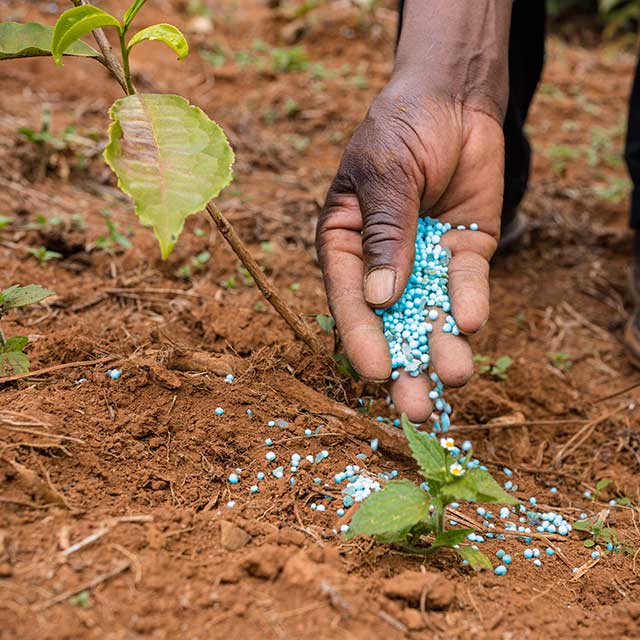Fertilizers Facts
Fall is here and most of you have started thinking about or already have fertilized your lawn, shrubs and trees. I thought a few facts on fertilizers and nutritional needs of plants might help you with your fertilizer choices.
Sixteen Elements
There are sixteen known elements required for plant growth and development. Three of these, carbon(C), hydrogen(H), and oxygen(O) are all obtained directly from air and water. The other thirteen elements are supplied by the soil. These are nitrogen (N), phosphorus (P), potassium (K), calcium (Ca), magnesium (Mg), sulfur (S), chlorine (Cl), copper (Cu), zinc (Zn), manganese (Mn), iron (Fe), boron (B), and molybdenum (Mo).
A Delicate Balance
These thirteen are elements plants obtain from the soil must be in a slightly soluble form so they can be taken up by the plant’s roots. Each of these elements has a specific function in plant growth and development. If one or more of these nutrients are present in excessive amounts, toxicity or a nutrient imbalance can occur. Or if one or more of these essential elements are in short supply a deficiency can result. Either way plant growth and/or quality may be affected.
Macro-nutrients
The nutrients, nitrogen, phosphorus and potassium are the main components, or macro-nutrients, of a suitable fertilizer. The State of Florida is reducing the phosphorus in this equation however as this macro-nutrient is causing pollution problems in local waterways. Sometimes dolomite, a liming material providing both calcium and magnesium, may be included in growing media. Sulfur, the remaining macro-nutrient, may not be a component of the fertilizer and should not be overlooked. Look for fertilizer containing sulfur coated urea nitrogen. This is especially important if you have the dreaded Take-all Patch disease in your lawn.
Nitrogen
Nitrogen is available in two basic forms – inorganic and organic. Plants have a preference for the inorganic, or nitrate form of nitrogen. There are two primary organic forms of nitrogen. One is a man made organic called urea. The other form is a naturally occurring organic material such as sewage sludge and manure. These organic forms of nitrogen are converted to the plant preferred inorganic nitrate form by bacterial action in the soil.
Soluble Nitrates
The soluble nitrate form of nitrogen is quickly available to the plant causing the rapid growth rate which may cause thin cell walls to develop. Nitrate nitrogen doesn’t last long in the environment. It can leach readily from the soil and may even be lost as a gas. Nutrients should be supplied at the same rate the plant can use them. This means soluble nitrates must be applied frequently in very small amounts.
“If you have plants which don’t do well around your pool equipment or overflow it may be chlorine toxicity.”
Micro-nutrients
The micro-nutrients to be used sparingly are boron, copper, iron, manganese, molybdenum, and zinc. Chlorine ordinarily is not valued as a plant food in fertilizer. It can be injurious if high percentages are present, but small amounts may be beneficial under some conditions. If you have plants which don’t do well around your pool equipment or overflow it may be chlorine toxicity.
Micro-nutrients
Micro-nutrients are required by plants in low quantities so you should apply them cautiously. If a deficiency is suspected, it would be unwise to randomly apply all of the micro-nutrients. The result might be correction of one deficiency while inducing a toxicity of another micro-nutrient. This could also lead to an unhealthy plant appearance. Foliar analysis is the most accurate way to determine if a micro-nutrient deficiency is in need of correction.
The Collier County Extension Office can help you with this test. Individual micro-nutrients are available with suggested rates provided for application. However, it is essential that all micro-nutrients be provided in your fertilizer program at least once a year. Fertilizer formulations are available for shrubs, citrus, palms, etc., containing a good balance of these necessary micro-nutrients. Nutritional sprays are liquid formulations that contain the micro-nutrients. These sprays allow the elements to enter the plant through the leaf surfaces.
The micro-nutrients can be tied up in our alkaline soil, due to improper pH, when applied as a granular fertilizer and may not be available to the plant. Therefore, when a micro-nutrient deficiency is apparent, it is more effective to apply a nutritional spray.
Following are some general symptoms of nutrient deficiencies:
Nitrogen – yellowing of entire plant with lower leaves worse and stunted.
Phosphorus – main veins of old leaves become purple or reddish. On fruit trees blossoms drop, fruit is small and matures slowly and few flower buds are formed for next year’s crop.
Potassium – faint yellowing, then browning of margins on old leaves. Then veins become yellow.
Manganese – mottled chlorosis between midrib and primary veins. Entire leaf may turn yellow but midrib and large veins stay green longest. Frizzle top, yellowing, dwarfing and distortion.
Iron – pronounced yellowing on younger leaves with veins appearing as fine green lines, yellow to white if acute. Dwarf leaves, leaf fall, dead wood, dead tips and reduced growth.
Magnesium – yellowing begins on margin and near center of old leaf, progresses inward and downward; tip, upper margin and lower central veins may remain green; necrosis and leaf drop.
Molybdenum – often mistaken for herbicide damage. Dwarfed leaves with irregular, wrinkled margins and prominent midribs and main veins on your leaves and shoots.
Boron – plants grow slowly. Terminal buds die and plant tends to be bushy. Later, lateral buds die, leaves thicken and fruits, tubers and roots become cracked and discolored.
Copper – usually confined to peat or muck soils. Slow growth or complete cessation of growth. Tips affected first and eventually die back.
Zinc – leaves become long and narrow, turn yellow and become mottled with dead areas. Symptoms similar to iron deficiency.
I hope these facts make this necessary chore in your yard a little easier to understand.







